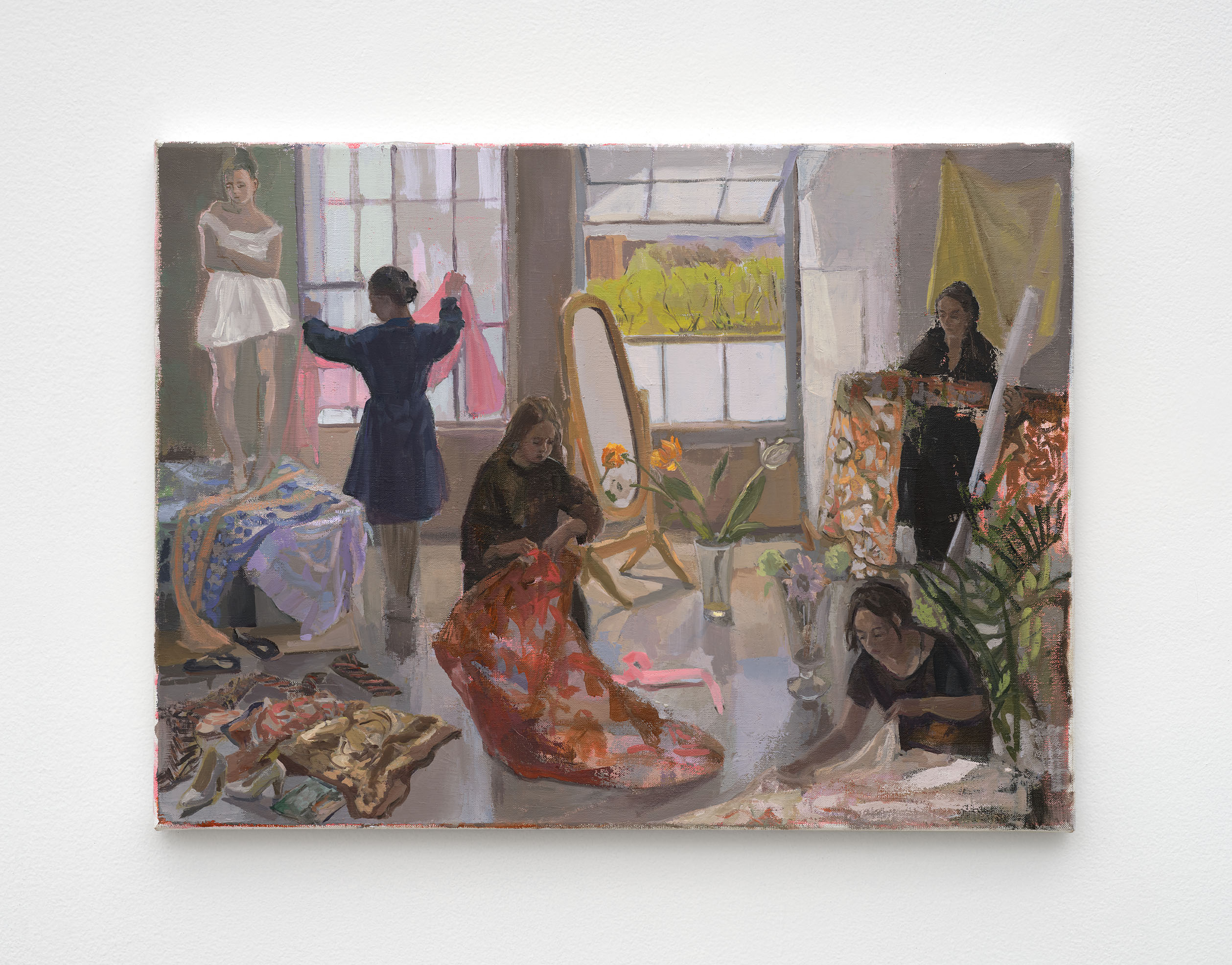waiting on tenterhooks
Antonia Brown, Martina Cox, and Vera
Iliatova


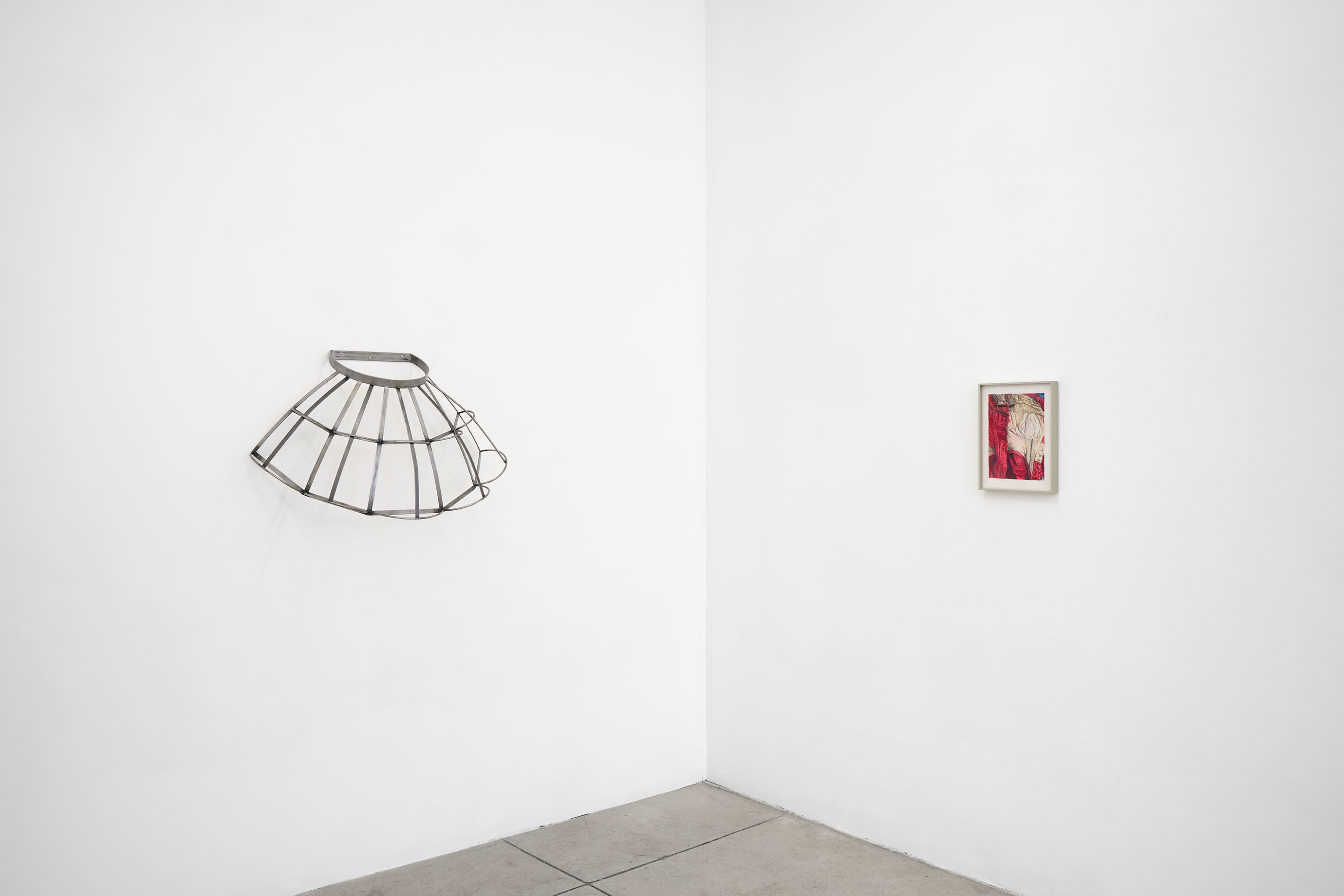
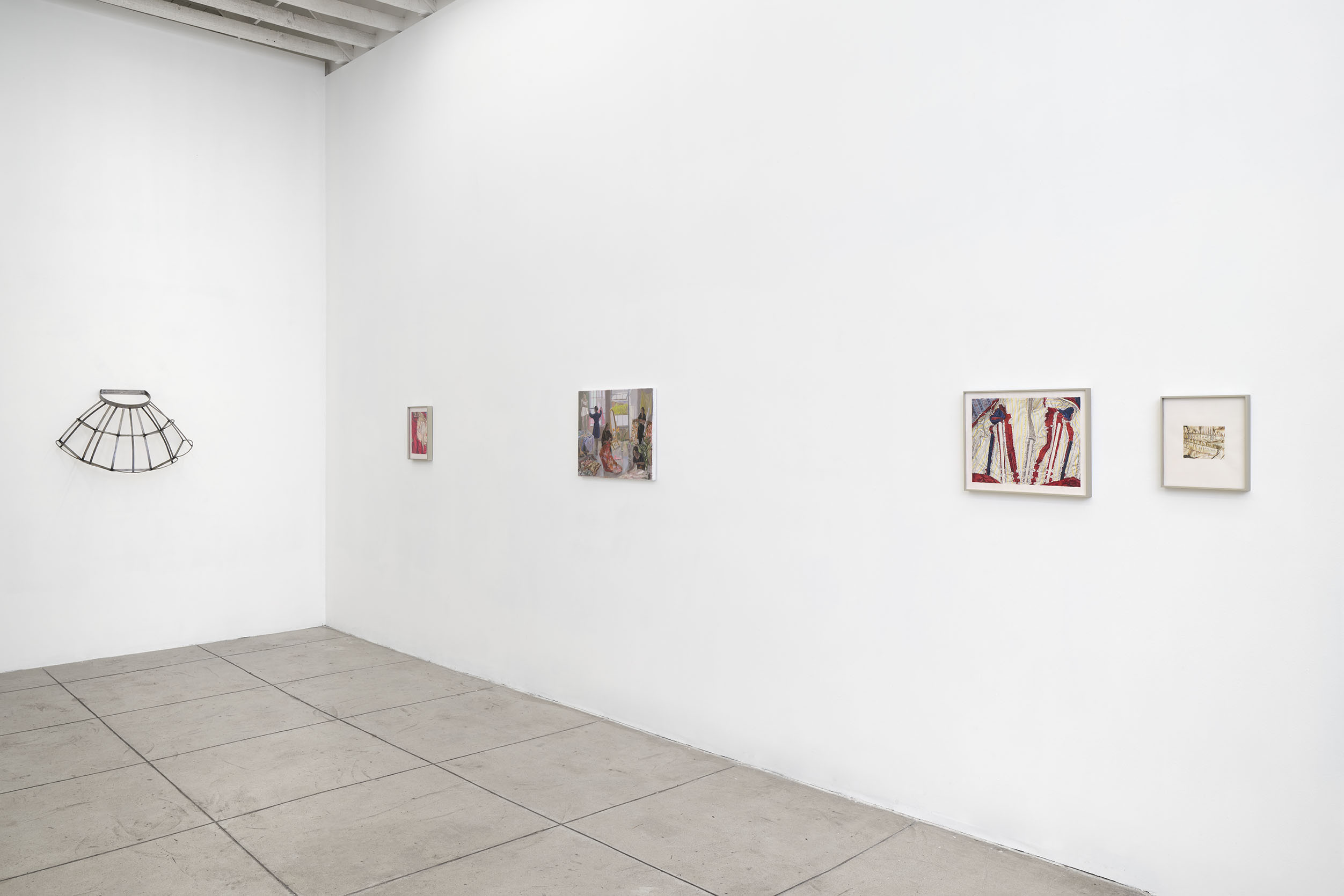

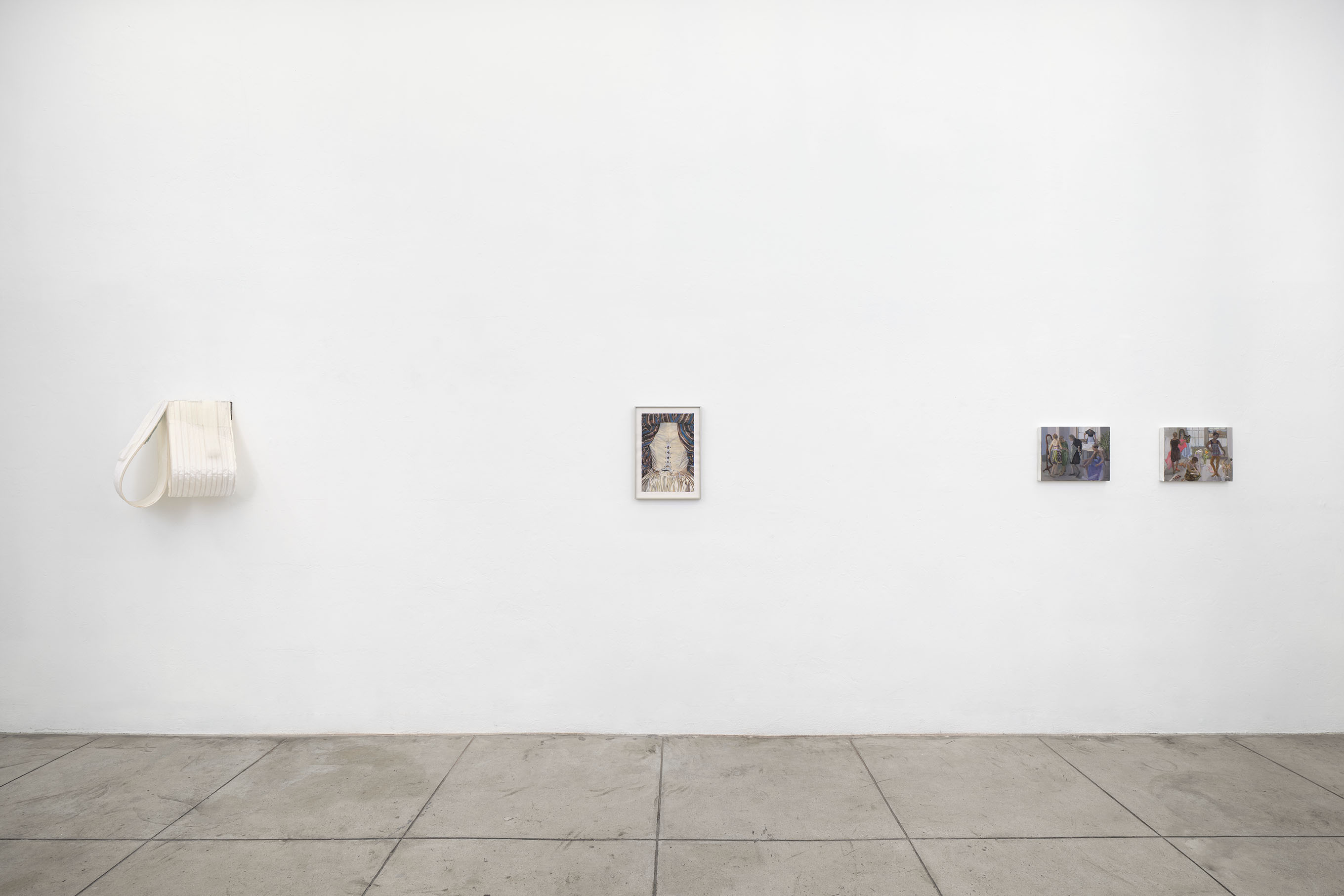


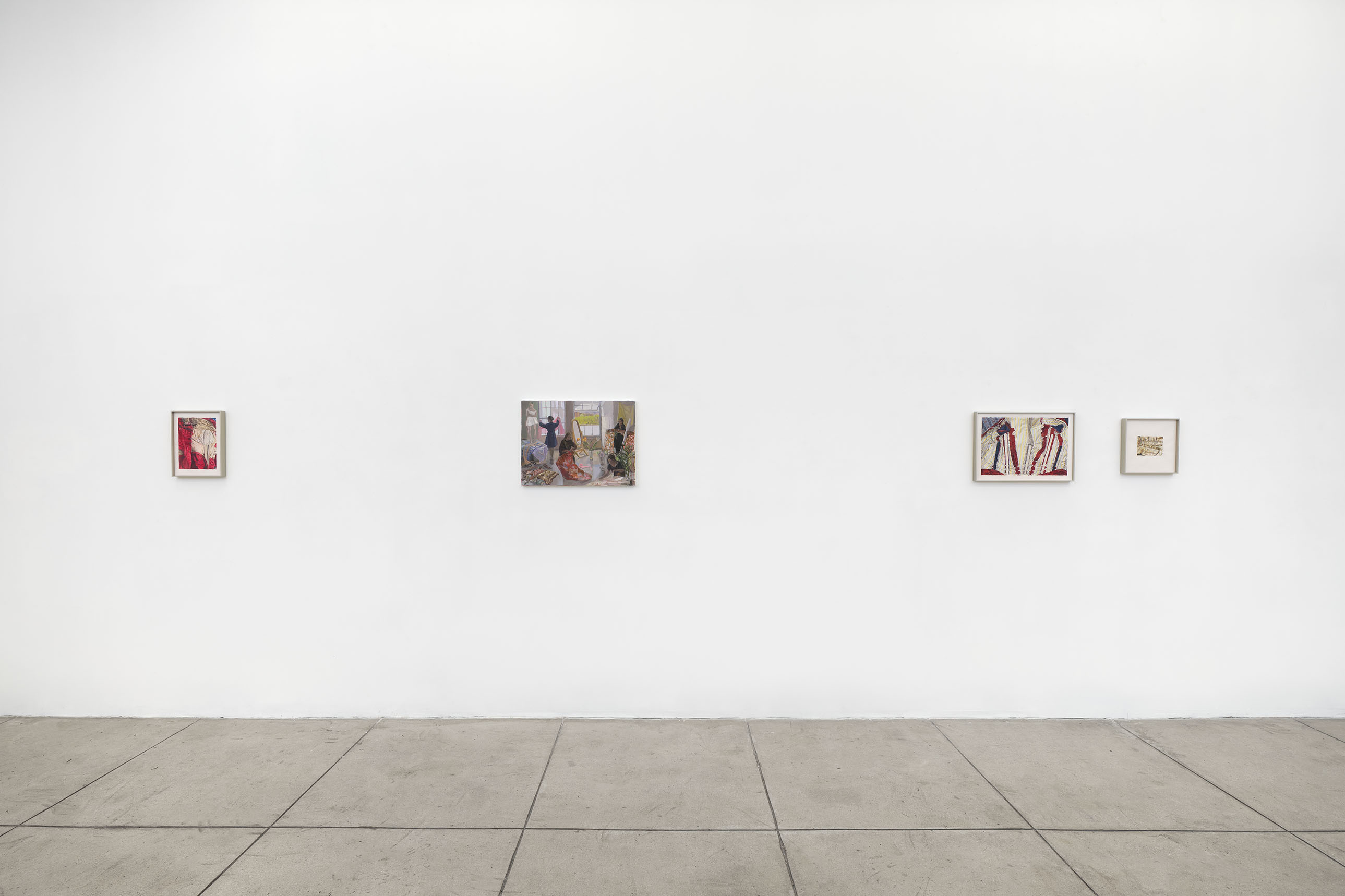

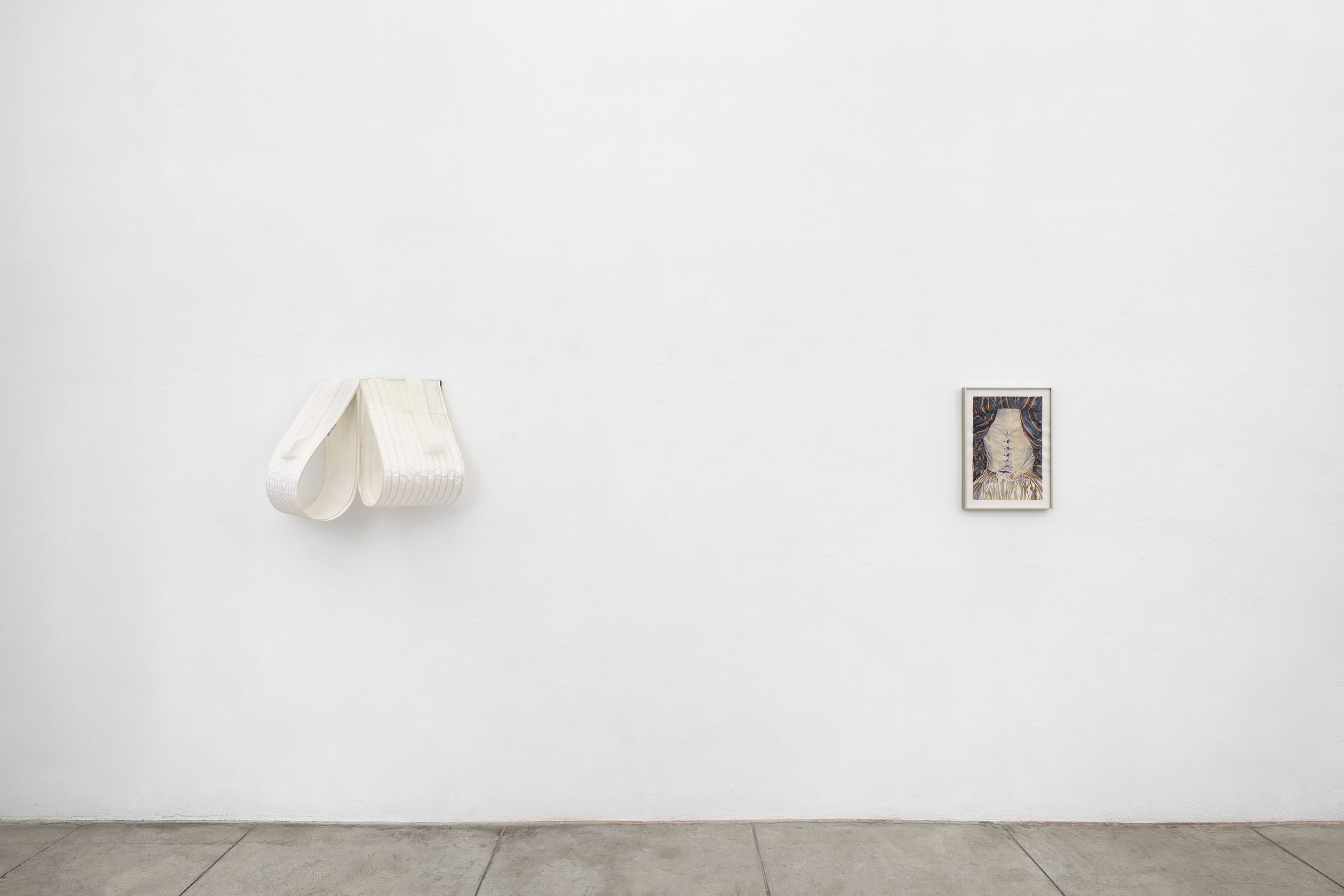
12.26 Los Angeles is pleased to present waiting on tenterhooks, a three-person exhibition that brings together Antonia Brown, Martina Cox, and Vera Iliatova.
waiting on tenterhooks explores the delicate tension between anticipation and transformation. The phrase, drawn from the now-antiquated use of hooked nails to stretch and hold cloth taut, evokes the nervous suspense of waiting – likened here to the simultaneous longing and confinement woven into the fabric of girlhood and womanhood for centuries. This feeling of anticipation is central to the presentation, as it reconciles the naïve yearning of adolescence, with the historical constraints imposed on the female body.
Nineteenth century clothing devices physically manifest this tension within the space: steel hooped crinolines, waist-cinching corsets, and remnants of interior boning structures are entangled with lush compositions of contemporary female-centered ateliers. However, these devices are largely removed from their intended social construct. They are rearranged, deconstructed, repurposed, and ultimately recontextualized. They serve as echoes of a collective memory. One that encourages a deeper understanding of the conflicting states of containment in historical women’s dress and the perceived unruliness in expressions of femininity that failed to conform to the narrow interpretation of a bygone era.
Working in different mediums, both Martina Cox and Antonia Brown dissect the ways that the female body has been contained, manipulated, and molded throughout history. Corsets restricted breathing, compressing the ribcage to achieve a desired silhouette, while crinolines and bustles added weight and limited mobility, inevitably forcing women to adapt their movements to the confines of their attire.
In both Cox’s intricate mixed media drawings, and Brown’s sculptures, the figure is noticeably absent. However, the suggestion of flesh, or rather the ghostly bodies that once inhabited the garments, is ever present in their respective works. In Cox’s Sowing to the Flesh, the gathered fabric feels reminiscent of sutured skin. Though small in scale, it is replete with handwoven yarn, thread, and a hook and eye closure. These details feel evocative of the physical endurance and meticulous labor required in the making and wearing of Nineteenth century garments. Similarly, Brown’s sculpture Untitled (Tournure, 1858) embodies an undeniable physicality. Composed solely of alluring steel, the material itself feels both elegant and unforgiving; aesthetically pleasing and painfully rigid. Ruminating on the construct of the feminine ideal, Brown’s work acknowledges and challenges traditional methods of discipline and control.
Vera Iliatova’s paintings offer the most contemporary rendition of women and textiles at work, capturing an industrial studio space composed of warm greys, and creamy blues. Her compositions, blending hyperrealism with dreamlike narratives, capture the primal, often chaotic beauty of girlhood. Here the female figure is not only present, but also an active participant. In reenacting the bittersweet rituals of adolescence, their actions are tinged with feelings of transformation, escapism, self-discovery, and longing. In these spaces, her female figures are simultaneously busy, yet undeniably comfortable in their individual moments of solitude. Together, the three artists explore the interplay of restriction and agency.
At its heart, waiting on tenterhooks interrogates the duality of anticipation: the freedom of youthful longing and the historical constraints of societal expectations on women. In reexamining the transition to womanhood through historical dress, and its associated symbolism, each artist challenges and offers new insights into this universal, yet deeply personal experience. To this end, waiting on tenterhooks acknowledges the physical weight and emotional labor of historical garments, while celebrating the unbridled impulses of girlhood and the resilience of those who inhabit its legacy.
This exhibition is curated by Brittani Lemonds.
Antonia Brown (b. 1989, South Africa) is an artist based between Cape Town and Brussels. She holds a BA in Fine Arts from the University of Witwatersrand in Johannesburg, and a MFA from the Piet Zwart Institute in Rotterdam. She has participated in various art residencies including Fondazione Ratti, Como in 2016 and Cité Internationale des Arts, Paris in 2018 and Morpho, Antwerp in 2023. In 2013 she was the recipient of the Martienssen Prize and the Newwork Prize in 2014. Her work has recently been shown at 12.26, Los Angeles, CA (2025); Castello di Rivoli, Turin, curated by Guido Santandrea and Marianna Vecellio (2024); Lucas Hirsch, Dusseldorf, Germany (2023); Kunsthal Mechelen, curated by Zeynep Kubat (2023); Fitzpatrick Gallery and Galerie Derouillon (Paris), Hinterconti (Hamburg) and 10n (Brussels), all in 2022.
Martina Cox (b. 1995, New York, NY) received her BFA from Cooper Union, New York, NY and was recently an artist-in-residence at the Textile Arts Center in Brooklyn, NY. Recent solo exhibitions include Waist Management at Alyssa Davis Gallery, New York, NY (2024). Recent group exhibitions include 12.26, Los Angeles, CA (2025); Kasmin Gallery, New York, NY (2025); Alyssa Davis Gallery, New York, NY (2022); Textile Arts Center, Brooklyn, NY (2023); among others. Her work has been featured in several publications including The New York Times, Elephant Magazine, Interview Magazine, LVL3, Coeval, and Sleek Magazine. Cox lives and works in New York, NY, where she is the organizer and host of mending club Darn it!
Vera Iliatova (b. 1975, St Petersburg, Russia) received a BA from Brandeis University and an MFA in Painting/Printmaking from Yale University, with further study at Skowhegan School of Art (2004) and residency at Marie Walsh Sharpe Foundation (2007/2008). In 2018, Iliatova was awarded a New York Foundation for the Arts Fellowship in Painting. She has exhibited across the U.S. as well as Italy, Germany, Denmark, and Great Britain. Her recent exhibitions include: 12.26, Los Angeles, CA (2025); Nathalie Karg Gallery, New York, NY (2024 and 2021); Andrews Gallery, College of William and Mary, Williamsburg, VA (2024); James Cohan Gallery, New York, NY (2023); Fahrenheit Madrid, Madrid, Spain (2021); Monya Rowe Gallery, New York, NY (2020, 2017, 2015); among others. Her work has been reviewed in Art Forum, Art in America, ARTnews, The New York Times, The Houston Chronicle, The Boston Globe, Time Out New York, Hyperallergic, and other publications.
waiting on tenterhooks explores the delicate tension between anticipation and transformation. The phrase, drawn from the now-antiquated use of hooked nails to stretch and hold cloth taut, evokes the nervous suspense of waiting – likened here to the simultaneous longing and confinement woven into the fabric of girlhood and womanhood for centuries. This feeling of anticipation is central to the presentation, as it reconciles the naïve yearning of adolescence, with the historical constraints imposed on the female body.
Nineteenth century clothing devices physically manifest this tension within the space: steel hooped crinolines, waist-cinching corsets, and remnants of interior boning structures are entangled with lush compositions of contemporary female-centered ateliers. However, these devices are largely removed from their intended social construct. They are rearranged, deconstructed, repurposed, and ultimately recontextualized. They serve as echoes of a collective memory. One that encourages a deeper understanding of the conflicting states of containment in historical women’s dress and the perceived unruliness in expressions of femininity that failed to conform to the narrow interpretation of a bygone era.
Working in different mediums, both Martina Cox and Antonia Brown dissect the ways that the female body has been contained, manipulated, and molded throughout history. Corsets restricted breathing, compressing the ribcage to achieve a desired silhouette, while crinolines and bustles added weight and limited mobility, inevitably forcing women to adapt their movements to the confines of their attire.
In both Cox’s intricate mixed media drawings, and Brown’s sculptures, the figure is noticeably absent. However, the suggestion of flesh, or rather the ghostly bodies that once inhabited the garments, is ever present in their respective works. In Cox’s Sowing to the Flesh, the gathered fabric feels reminiscent of sutured skin. Though small in scale, it is replete with handwoven yarn, thread, and a hook and eye closure. These details feel evocative of the physical endurance and meticulous labor required in the making and wearing of Nineteenth century garments. Similarly, Brown’s sculpture Untitled (Tournure, 1858) embodies an undeniable physicality. Composed solely of alluring steel, the material itself feels both elegant and unforgiving; aesthetically pleasing and painfully rigid. Ruminating on the construct of the feminine ideal, Brown’s work acknowledges and challenges traditional methods of discipline and control.
Vera Iliatova’s paintings offer the most contemporary rendition of women and textiles at work, capturing an industrial studio space composed of warm greys, and creamy blues. Her compositions, blending hyperrealism with dreamlike narratives, capture the primal, often chaotic beauty of girlhood. Here the female figure is not only present, but also an active participant. In reenacting the bittersweet rituals of adolescence, their actions are tinged with feelings of transformation, escapism, self-discovery, and longing. In these spaces, her female figures are simultaneously busy, yet undeniably comfortable in their individual moments of solitude. Together, the three artists explore the interplay of restriction and agency.
At its heart, waiting on tenterhooks interrogates the duality of anticipation: the freedom of youthful longing and the historical constraints of societal expectations on women. In reexamining the transition to womanhood through historical dress, and its associated symbolism, each artist challenges and offers new insights into this universal, yet deeply personal experience. To this end, waiting on tenterhooks acknowledges the physical weight and emotional labor of historical garments, while celebrating the unbridled impulses of girlhood and the resilience of those who inhabit its legacy.
This exhibition is curated by Brittani Lemonds.
Antonia Brown (b. 1989, South Africa) is an artist based between Cape Town and Brussels. She holds a BA in Fine Arts from the University of Witwatersrand in Johannesburg, and a MFA from the Piet Zwart Institute in Rotterdam. She has participated in various art residencies including Fondazione Ratti, Como in 2016 and Cité Internationale des Arts, Paris in 2018 and Morpho, Antwerp in 2023. In 2013 she was the recipient of the Martienssen Prize and the Newwork Prize in 2014. Her work has recently been shown at 12.26, Los Angeles, CA (2025); Castello di Rivoli, Turin, curated by Guido Santandrea and Marianna Vecellio (2024); Lucas Hirsch, Dusseldorf, Germany (2023); Kunsthal Mechelen, curated by Zeynep Kubat (2023); Fitzpatrick Gallery and Galerie Derouillon (Paris), Hinterconti (Hamburg) and 10n (Brussels), all in 2022.
Martina Cox (b. 1995, New York, NY) received her BFA from Cooper Union, New York, NY and was recently an artist-in-residence at the Textile Arts Center in Brooklyn, NY. Recent solo exhibitions include Waist Management at Alyssa Davis Gallery, New York, NY (2024). Recent group exhibitions include 12.26, Los Angeles, CA (2025); Kasmin Gallery, New York, NY (2025); Alyssa Davis Gallery, New York, NY (2022); Textile Arts Center, Brooklyn, NY (2023); among others. Her work has been featured in several publications including The New York Times, Elephant Magazine, Interview Magazine, LVL3, Coeval, and Sleek Magazine. Cox lives and works in New York, NY, where she is the organizer and host of mending club Darn it!
Vera Iliatova (b. 1975, St Petersburg, Russia) received a BA from Brandeis University and an MFA in Painting/Printmaking from Yale University, with further study at Skowhegan School of Art (2004) and residency at Marie Walsh Sharpe Foundation (2007/2008). In 2018, Iliatova was awarded a New York Foundation for the Arts Fellowship in Painting. She has exhibited across the U.S. as well as Italy, Germany, Denmark, and Great Britain. Her recent exhibitions include: 12.26, Los Angeles, CA (2025); Nathalie Karg Gallery, New York, NY (2024 and 2021); Andrews Gallery, College of William and Mary, Williamsburg, VA (2024); James Cohan Gallery, New York, NY (2023); Fahrenheit Madrid, Madrid, Spain (2021); Monya Rowe Gallery, New York, NY (2020, 2017, 2015); among others. Her work has been reviewed in Art Forum, Art in America, ARTnews, The New York Times, The Houston Chronicle, The Boston Globe, Time Out New York, Hyperallergic, and other publications.


